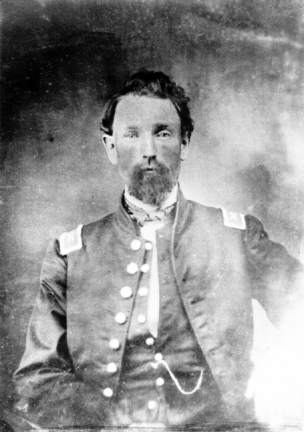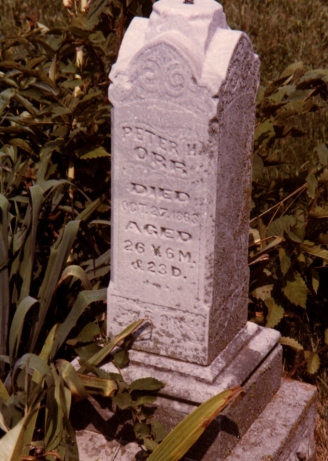
 HOME HOME
 BIOS BIOS
|

Lieutenant Peter H. Orr
1837 - 1863
Peter H. Orr was one of the early pioneers of Lewis County, Missouri
and one of the unsung heroes of the Civil War.
by Jim Morriss, 2002
Peter H. Orr
2nd Lt. 21st Missouri Infantry
Pete was born in New York on April 4, 1837 to parents who had
recently migrated from Scotland. His family moved west to northeastern Illinois where Pete
and his brothers and sisters grew up. After the death of their parents (possibly because of
a typhoid epidemic) most of the Orr family moved to Lewis County. Pete bought 80 acres of
land near Deer Ridge in 1858 with the sincere desire to settle down and become a Missouri
farmer. Unfortunately the political dissension that was soon to erupt into the Civil War
interfered with Pete’s plans. The Orr family were devout members of the Presbyterian faith.
They were firmly opposed to the institution of slavery but not to an extent that would label
them abolitionists. By 1861 there were bands of armed men roving through northeast Missouri.
Some were anti-slavery gangs who went around bullying Secessionists. There were also
Confederate Sympathizers who beat up any Union Loyalists they encountered. The Lewis county
countryside was no place to be a peaceful farmer and would not be until one side defeated
the other.
In February of 1862, Peter and his brother William decided to leave their farms in the hands
of their younger siblings and join the army. There was an intense patriotic passion in many
of the towns along the Mississippi river and thousands of young men were being recruited to
save the Union. The two traveled to Canton where they signed on with the 21st Missouri
Infantry. With very little time for training or even to become acquainted with his fellow
soldiers, Pete found himself elected Sergeant of Company F, under the leadership of Captain
Joseph T. Farris. The 21st Regiment became a part of the 1st Brigade, which was a part of the
6th Division of the Army of the Tennessee. In less than two months the 40,000 soldiers of this
army were herded onto paddle wheel steam boats and sent up the Tennessee River to a place
called Pittsburg Landing. On April 5, 1862 the 21st Regiment was in the most advanced position
about three miles southeast of the steamboat landing.
This is the exact spot on the Tennessee River where Pete Orr's
regiment debarked, 140 years previously, to play a pivital role
in the battle of Shiloh
It was the intention of General U.S. Grant to gather his troops on this “beach head” and march
them over the muddy road to take over the rail facilities at Corinth, Mississippi. Albert
Sidney Johnston the Commander of the Confederate Army had no intention of waiting until Grant
was ready to fight. He marched his army to the river and encountered the advanced pickets of
the 21st and 25th Missouri Regiments. Pete Orr happened to be in the forefront of what would
become known as the Battle of Shiloh. Although many of the members of the Union Army were
routed in the first day of the battle, the four regiments of the 1st Brigade held on with
stubborn determination. This unit of soldiers dug in at a place they called the “Hornet’s
Nest” and held off the advancing Confederates. Grant freely admitted afterwards that their
actions not only prevented a humiliating defeat but was a turning point of the battle.
Many of the soldiers of the 21st Regiment were killed, wounded or captured but Pete survived
to make the 22-mile march to Corinth where on May 30, the Union Army finally occupied the town.
Pete Orr’s Regiment was a part of the force that pursued the fleeing Rebel Army in a running
battle that lasted until June 12. Pete and the rest of the contingent from Missouri remained
on duty throughout the summer, then fought and won the Battle of Iuka on September 19, 1862.
His regiment was ordered to return to Corinth where they defended that city against a
Confederate attempt to recapture it.
There are no reports of individual deeds done by Pete Orr, but there is every reason to believe
he was an exemplary soldier. On March 6, 1863 he was given a promotion to the rank of 2nd
Lieutenant. Shortly thereafter Pete had a Daguerreotype photo made, which he sent home. In the
spring and summer of 1863 the 21st Regiment was assigned to duty in western Kentucky and
Tennessee. The army was ordered to interrupt the traffic of contraband material (mostly baled
cotton) which was being smuggled northward for conversion into hard currency. Ulysses S. Grant
was well aware that this money was being used by determined Southerners to buy guns, ammunition
and vital supplies for the Armies of the Confederacy. The effects of the Union blockade and the
successes of the U.S. Army to cut off the flow of material was having a profound effect on the
ability of South to continue the fight. The occupation was also creating a considerable and
growing feeling of resentment in that part of the country. The soldiers of the 21st Missouri
Regiment were deep inside hostile enemy territory and they knew it. In the fall of 1863 they
were camped near Union City, Tennessee. Pete left camp late in the afternoon to get a better
look at the area that his regiment was operating in. He returned to camp shortly after dusk and
was challenged by one of the soldiers on guard duty. Pete either did not respond with the
proper password or perhaps responded too slowly and was shot by the sentry.
Lieutenant Peter Orr died a few hours later that night, October 27, 1863. H.M. Woodyard, the
Commander of the 1st Brigade, who had been with Pete throughout the many battles of the
previous 20 months, immediately initiated plans for a funeral that would be suitable for the
fallen hero. A special gravesite was secured and the participation of the military band from
the 119th Illinois Regiment was promised. But Pete’s close friends petitioned the army brass
to have his remains returned to his family in Lewis County. It was rare for a Civil War
soldier to be returned home for burial but because of Pete’s reputation, and because his
death occurred during cool weather, the request was granted.
Pete’s body was sent to his two sisters who had been forced to move to town for their safety.
They provided the best funeral possible but because of their own displacement and because of
the social disruptions caused by the war, the service for a true local hero must have been
limited. A battle flag and the officer’s sword were sent home along with Pete’s body. The
sword and flag were passed on to Pete’s brother John, who was the only one of the four Orr
brothers to return from the war alive. John bestowed them along with stories of his brother
to his daughter Abigail and to his granddaughter Ivah, both of who lived in LaBelle. The
sword and flag remained in the family for over ninety years but were lost in a home burglary
in the 1950’s. Fortunately the old tin-type photo and the stories endured and were told to me
by Ivah Morriss who was my grandmother. The stone that marks the spot where Pete Orr was
buried remains one of the oldest in the LaBelle Cemetery. It is just one tangible record of
the existence of a simple farm boy who came from Lewis County, Missouri. He joined with a
like-minded group of friends and neighbors who participated in the greatest struggle of our
country’s history. He performed bravely in several battles. Pete Orr has been at rest for
nearly 140 years. Like many who served in the Civil War, he may never receive the praise he
deserves, but he has been and will be remembered.
Gravesite of Peter H. Orr in the LaBelle Cemetery
SOURCES:
Jim Morriss’ interviews with Ivah Morton Morriss and Elsie Spidle Ledbetter,
granddaughters of John Orr.
Probate records of Lewis Co. Mo: Final Settlement of Peter H. Orr, November 23, 1868
“A Compendium of the War of Rebellion” by Frederick H. Dyer, 1908. Vol. 3, Page 1330
“The Twenty-First Missouri” by Leslie Anders, Greenwood Press, 1975. Pages 120 & 150
“Grant Moves South” by Bruce Catton, Castle Books, 2000. Pages 210 - 264
“Hearts in Conflict” by Curt Anders, Barnes & Noble Books, 1994. Pages 96 - 102
“The Roster of Union Soldiers, 1861 - 1865” edited by Janet B. Hewett, Broadfoot Publishing Co. 1996
Federal Census Records:
- 1850 Cook Co. Ill, Bloom Twp. Roll T6-78, P19, Dwg#244
- 1850 Cook Co. Ill, Bloom Twp. Roll T6-78, P20, Dwg#249
- 1860 Lewis C. Mo, Reddish Twp. Roll M653-629, P 129, Dwg#192, Line 37
- 1860 Lewis C. Mo, Reddish Twp. Roll M653-629, P 130, Dwg#193, Line 3
Army Official Records, Series 1 - Volume X/1, S#10, Battle of Pittsburg Landing:
- No. 78: Report of Brig. Gen. B.M. Prentiss, 6th Division, Army of the Tennessee, Nov. 17, 1862
- No. 79: Report of Col. F. Quinn, 12th Michigan Infantry, April 9, 1862
- No. 80: Report of Col. D. Moore, 21st Missouri Volunteers, April 11, 1862
- No. 81: Report of Lt. Col. H.M. Woodyard, 21st Missouri Volunteers, April 12, 1862
Army Official Records, Series 1 - Volume XVII/1, S#24, Battle Corinth, Mississippi
- No. 91: Report of Col. H.M. Woodyard, 21st Missouri Volunteers, Oct. 3-12, 1862
Army Official Records, Series 1 - Volume XXIII/2, S#35, Battle of Pittsburg Landing:
- No. 13: Report of Brig. Gen. Asboth, Commanding Officer, May 11, 1863
Internet Links:
- https://members.tripod.com/~greatamericanhistory/gr02008.htm
- http://www2.cr.nps.gov/abpp/battles/tn003.htm
- http://www2.cr.nps.gov/abpp/battles/ms016.htm>
- http://www2.cr.nps.gov/abpp/battles/ms001.htm
- http://www2.cr.nps.gov/abpp/battles/ms002.htm
|
The information on this web site is for your personal use only. All pages, files, compilations, transcriptions, abstracts, and scanned images are protected by copyright law and may not be copied in whole or in part and published or redistributed in any manner without written consent of the author, contributor and/or webmaster. 
Copyright © 1999-2003 Brenda Schnurrer . All rights reserved. |



